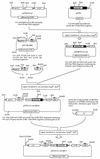Development and field performance of a broad-spectrum nonviable asporogenic recombinant strain of Bacillus thuringiensis with greater potency and UV resistance
- PMID: 10473413
- PMCID: PMC99738
- DOI: 10.1128/AEM.65.9.4032-4039.1999
Development and field performance of a broad-spectrum nonviable asporogenic recombinant strain of Bacillus thuringiensis with greater potency and UV resistance
Abstract
The main problems with Bacillus thuringiensis products for pest control are their often narrow activity spectrum, high sensitivity to UV degradation, and low cost effectiveness (high potency required). We constructed a sporulation-deficient SigK(-) B. thuringiensis strain that expressed a chimeric cry1C/Ab gene, the product of which had high activity against various lepidopteran pests, including Spodoptera littoralis (Egyptian cotton leaf worm) and Spodoptera exigua (lesser [beet] armyworm), which are not readily controlled by other Cry delta-endotoxins. The SigK(-) host strain carried the cry1Ac gene, the product of which is highly active against the larvae of the major pests Ostrinia nubilalis (European corn borer) and Heliothis virescens (tobacco budworm). This new strain had greater potency and a broader activity spectrum than the parent strain. The crystals produced by the asporogenic strain remained encapsulated within the cells, which protected them from UV degradation. The cry1C/Ab gene was introduced into the B. thuringiensis host via a site-specific recombination vector so that unwanted DNA was eliminated. Therefore, the final construct contained no sequences of non-B. thuringiensis origin. As the recombinant strain is a mutant blocked at late sporulation, it does not produce viable spores and therefore cannot compete with wild-type B. thuringiensis strains in the environment. It is thus a very safe biopesticide. In field trials, this new recombinant strain protected cabbage and broccoli against a pest complex under natural infestation conditions.
Figures


Similar articles
-
Construction of new insecticidal Bacillus thuringiensis recombinant strains by using the sporulation non-dependent expression system of cryIIIA and a site specific recombination vector.J Biotechnol. 1996 Jul 18;48(1-2):81-96. doi: 10.1016/0168-1656(96)01404-6. J Biotechnol. 1996. PMID: 8818275
-
Insecticidal activity of Bacillus thuringiensis Cry1Bh1 against Ostrinia nubilalis (Hubner) (Lepidoptera: Crambidae) and other lepidopteran pests.Appl Environ Microbiol. 2013 Dec;79(24):7590-7. doi: 10.1128/AEM.01979-13. Epub 2013 Sep 27. Appl Environ Microbiol. 2013. PMID: 24077715 Free PMC article.
-
[Construction of insecticidal recombinant Bacillus thuringiensis using an integrative vector].Yi Chuan Xue Bao. 2003 Aug;30(8):737-42. Yi Chuan Xue Bao. 2003. PMID: 14682242 Chinese.
-
[Bacillus thuringiensis: a biotechnology model].J Soc Biol. 1999;193(6):523-30. doi: 10.1051/jbio/1999193060523. J Soc Biol. 1999. PMID: 10783711 Review. French.
-
Encapsulation Strategies for Bacillus thuringiensis: From Now to the Future.J Agric Food Chem. 2021 Apr 28;69(16):4564-4577. doi: 10.1021/acs.jafc.0c07118. Epub 2021 Apr 13. J Agric Food Chem. 2021. PMID: 33848162 Review.
Cited by
-
Transcriptional regulation and characteristics of a novel N-acetylmuramoyl-L-alanine amidase gene involved in Bacillus thuringiensis mother cell lysis.J Bacteriol. 2013 Jun;195(12):2887-97. doi: 10.1128/JB.00112-13. Epub 2013 Apr 19. J Bacteriol. 2013. PMID: 23603740 Free PMC article.
-
Regulation of cry gene expression in Bacillus thuringiensis.Toxins (Basel). 2014 Jul 23;6(7):2194-209. doi: 10.3390/toxins6072194. Toxins (Basel). 2014. PMID: 25055802 Free PMC article. Review.
-
Characterization of a novel cell wall hydrolase CwlE involved in Bacillus thuringiensis subsp. israelensis mother cell lysis.Front Microbiol. 2023 Sep 27;14:1250542. doi: 10.3389/fmicb.2023.1250542. eCollection 2023. Front Microbiol. 2023. PMID: 37829449 Free PMC article.
-
Characteristics of the sigK Deletion Mutant from Bacillus thuringiensis var. israelensis Strain Bt-59.Curr Microbiol. 2020 Nov;77(11):3422-3429. doi: 10.1007/s00284-020-02150-9. Epub 2020 Aug 8. Curr Microbiol. 2020. PMID: 32770390
-
Single Amino Acid Substitution in Homogentisate Dioxygenase Affects Melanin Production in Bacillus thuringiensis.Front Microbiol. 2018 Oct 11;9:2242. doi: 10.3389/fmicb.2018.02242. eCollection 2018. Front Microbiol. 2018. PMID: 30364256 Free PMC article.
References
-
- Arantes O, Lereclus D. Construction of cloning vectors for Bacillus thuringiensis. Gene. 1992;108:115–119. - PubMed
Publication types
MeSH terms
Substances
LinkOut - more resources
Full Text Sources
Research Materials

